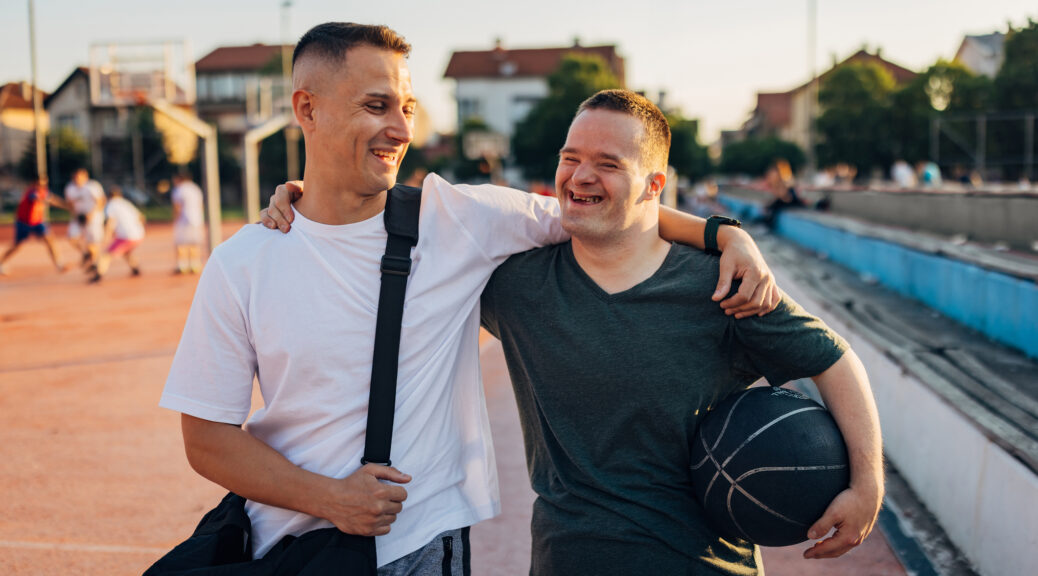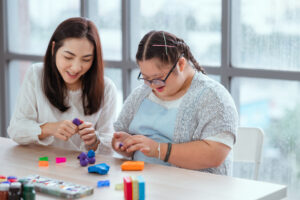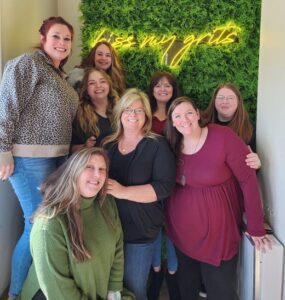Supporting Individuals with Developmental Disabilities through Inclusive Communication

When talking either with or about a person with one or more developmental disabilities, it can be easy to feel overwhelmed or worried about saying the wrong thing. While this is a very common response in our culture today, it’s important to learn how to better communicate with, support and speak about individuals with disabilities to be more inclusive and effective communicators. As the saying goes, when we know better, we do better.
 March is Developmental Disabilities Awareness Month, a time to celebrate how people with and without disabilities come together to form strong communities. As we commemorate this month, let’s explore some strategies for more effective, inclusive and thoughtful communication with people who have developmental disabilities.
March is Developmental Disabilities Awareness Month, a time to celebrate how people with and without disabilities come together to form strong communities. As we commemorate this month, let’s explore some strategies for more effective, inclusive and thoughtful communication with people who have developmental disabilities.
What to Understand About Individuals with Developmental Disabilities
Developmental disabilities are defined by the CDC as “a group of conditions due to an impairment in physical, learning, language or behavior areas.” In the United States, about 1 in 6 children have one or more developmental disabilities. Some common developmental disabilities include sensory processing disorders, developmental delays, learning disabilities and metabolic developmental disabilities.
As we discuss the challenges individuals with developmental disabilities face and how we can foster inclusive communication and interactions, it’s tempting to discuss what’s different. And it can be easy to forget the personhood of individuals with disabilities and only see their limitations. So the best place to begin, explains KVC Nebraska Director of Developmental Disabilities Hannah Tamayo, is with what all of us have in common.
“Individuals with disabilities are just like everybody else,” explains Tamayo “We all have our individual abilities: things we are excellent at, things that we need more assistance with and areas we’re still learning.” This mentality is central to making inclusive language your natural inclination when interacting with individuals who have disabilities.
Unique Challenges Faced by Individuals with Developmental Disabilities
It’s common for individuals with disabilities to feel like they lack independence and agency within the community or even within their own lives. For example, someone might choose to ask a caregiver or interpreter what the individual with a developmental disability wants or needs instead of asking that individual directly. While the intent may be positive, the impact can be negative.
Tamayo shares how KVC seeks to create more empowering environments with clients. This can include trying a shared living model or finding employment based on what the client is interested in.
“We work really hard at KVC to promote someone’s independence and also make sure people with disabilities have their voices heard,” she says.
When talking to an individual about the services and support they may want or need, it can be impactful to prioritize empowering that individual. We aim to ensure their desires are heard and met to the best of our ability.
Why Effective Inclusive Communication and Interaction Matters
Inclusive communication and interaction focus on making sure every single person is seen, heard and understood. Prioritizing engaging with a person, whether one-on-one or in a group is crucial. Thoughtful communication gives them tools to process and respond. Inclusive communication sets the stage for each person to contribute with their thoughts, opinions or questions.
As Tamayo explains it, “You’re not only letting people have a seat at the table, but you’re also making sure that they can have a say at the table.” What does this look like in practice? Inclusive communication differs depending on the situation and the people involved. It might mean having an interpreter at events to enhance accessibility for individuals with hearing disabilities. It could look like taking pauses during meetings to allow individuals to take notes or process information and formulate a thoughtful response. Whatever it looks like, the ultimate goal is to include everyone in the conversation, regardless of whether or not they have a developmental disability.
Communication Strategies for Empowering Individuals with Developmental Disabilities
Even with the understanding that an individual with a developmental disability is just as able as you or me, it can still feel intimidating to strike up a conversation. You might still worry about inadvertently saying the wrong thing. Here are some tips for making your communications both inclusive and approachable to every person:
Be Patient
Not everyone processes information at the same rate, and not everyone has the same knowledge going into a conversation or interaction. Give people you communicate with time to think and respond and take this as an opportunity to slow down and allow space.
Use Clear, Simple Language
By using clear and simple language, we don’t mean talking down or belittling someone with your speech. When talking to an adult with a developmental disability, treat them as an adult and not as you would a child. At the same time, you can keep your language approachable and concise, using words and phrases that are common and understandable. If the person you are speaking with doesn’t understand, try rephrasing in a simpler way.
Talk to the Individual
When talking to a person with a disability, talk to them, not to their caregiver or support person. They may have an interpreter or caregiver there to help, but it’s important to treat the individual as their own person and ask them directly about their thoughts, interests and preferences.
Ask Questions
 Don’t be afraid to ask an individual questions about their disability, what they need, what they want and even about their interests and dislikes! When it comes to inclusive communication, embrace genuine curiosity. This can make things more relational and engaging on both sides. When you ask a person with a disability about this, most will say that they would rather people ask them than assume their needs or ignore them entirely, as is more commonly the case.
Don’t be afraid to ask an individual questions about their disability, what they need, what they want and even about their interests and dislikes! When it comes to inclusive communication, embrace genuine curiosity. This can make things more relational and engaging on both sides. When you ask a person with a disability about this, most will say that they would rather people ask them than assume their needs or ignore them entirely, as is more commonly the case.
Use Person-First Language
Even when talking (or writing) about individuals with disabilities, it’s important to always use person-first language. This shift in our phrasing puts the person at the forefront rather than their disability, empowering them and promoting their capabilities. Here are two methods for implementing person-first language:
- Put the person first. For example, instead of referring to someone as a “disabled person,” use the phrase, “person with disabilities.” Notice how you’re putting the person before the descriptor?
- Focus the language on capability rather than limitation. A good example of this is shifting away from the phrase “wheelchair-bound,” which treats the wheelchair as a limitation and focuses on disability. A better phrase to use would be “utilizes a wheelchair,” which recognizes the wheelchair as a tool that helps the person to be capable and an active participant in their life.
In addition, avoid using derogatory or demeaning terms and language that create negative connotations around disabilities and individuals with disabilities.
Join KVC in Fostering an Inclusive and Supportive Environment!
By embracing curiosity, promoting empathy and understanding and building positive interactions when communicating with individuals who have disabilities, you are already doing your part to foster a more inclusive world for everyone. At KVC Nebraska, we work with families who are supporting individuals with disabilities in a home setting through our Shared Living Program and other resources created to empower individuals with disabilities. If you want to be a part of what we’re doing, donate to support us or learn how you can become a shared living provider.



